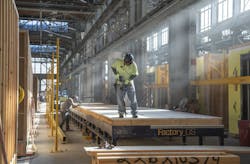The San Francisco Bay Area’s housing crunch is not exactly an industry secret. Still, the data is jolting.
San Francisco has the highest construction costs per square foot in the world, according to consulting firm Turner & Townsend. It’s also the fourth least affordable housing market in the country, reports real estate website RealtyHop.
At the same time, the area’s tech giants have been on a hiring spree: Last year, the Bay Area’s tech jobs increased by 11.5 percent. To keep up with its growth, the region should have built an additional 700,000 homes over the past 20 years, and it will need another 2.2 million housing units by 2070, according to urban planning policy think tank SPUR. In short, more people need more housing that isn’t getting built.
Add to that reality the high costs, lengthy timelines, and chronic inefficiencies of traditional stick-frame construction, as well as the industry’s dire labor shortage, and the region has an explosive situation on its hands.
“It’s a real crisis,” says Rick Holliday, CEO and cofounder, Factory_OS.
Builders like Factory_OS think their industry needs to take a different approach: offsite construction. In its 256,000-square-foot Bay Area factory, Factory_OS constructs multifamily modular buildings more cheaply and more efficiently by combining pioneering technology with traditional manufacturing methods. As a result, the company says it builds housing 40 percent faster and at 20 percent less cost. And it plans to go further, halving construction time and reducing costs by 30 percent.
Last year, Factory_OS won the inaugural Ivory Prize for housing affordability.
Factory_OS finds cost savings, in part, through technology. It uses Autodesk software to digitize and standardize its modular design. And by having its people work and communicate all in one building, the company cuts out many of the inefficiencies of onsite construction—where workers often wait around, tradespeople point fingers at one another for any delays, and multiple email threads lead to lags in communication.
— Rick Holliday, CEO and cofounder, Factory_OS
“At Factory_OS, we can resolve conflicts more quickly and standardize more easily,” Holliday says.
But faced with the area’s high worker costs, Factory_OS also has had to find labor savings. “No matter how much we automate, we still need more bodies. We need trained construction workers,” Holliday says.
In San Francisco, a construction worker makes an average of $90 per hour—but not at Factory_OS, which says it pays its 300 full-time construction workers up to $60,000 a year. It saves on labor by partnering with the Northern California Carpenters Regional Council to hire union workers, some of whom have served time, Holliday says. “We give them a second chance. And when you give a second chance to workers who are ready for it, they’re really, really good workers. We’re getting more productivity and more stability.”
That relationship has led to another benefit. Many public affordable housing projects have a union or prevailing wage requirement. By employing union workers, Factory_OS easily meets that requirement.
About three quarters of Factory_OS’s units are affordable housing, with the remainder going for market value. So when it saves money, governments and taxpayers save money, too.
The city of San Francisco spends at least $600,000 over seven years to build one unit of permanent housing, according to Tipping Point, a nonprofit fighting poverty in the Bay Area. And it costs the city $750,000 to build an “affordable housing” two-bedroom apartment—compared to the average U.S. home cost of $240,000.
But next year, in partnership with Factory_OS, the Northern California Carpenters Union, and affordable housing organization Mercy Housing, Tipping Point will have completed 145 units in under three years for less than $400,000 per unit.
“The city of San Francisco is ecstatic,” Holliday says.
The tech industry shares that enthusiasm. Factory_OS has attracted Google’s attention—and investment. Google has allocated $115 million to building affordable housing in Silicon Valley and plans to build around 24,000 new affordable housing units. That’s more than five times its original estimate, thanks to modular housing construction.
Still, Factory_OS, founded in 2017, has had some typical startup growing pains. Early on, it encountered the developer’s chicken-and-egg predicament: not getting work without a track record and not having a track record without work. Holliday overcame that by taking a few projects he already had and applying Factory_OS’s process to them, so that partners and lenders saw what the company could do. The startup had to have a reliable pipeline of work to justify staffing and training.
“It’s a confidence game in the first year or so because you haven’t done anything yet,” Holliday says. “Breaking that initial barrier is hard.”
Consider it broken. Now, Factory_OS is constructing about 800 units per year, with requested projects totaling about $800 million—and with plans to build a second factory.
